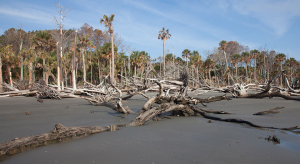Ghost forests, an indicator of climate change
Why in the news?
- Scientists have documented the link between the ghost forests and sea-level rising.
- Let us understand both the terms in detail and know their relation.
What is sea level rise?
- Sea-level rise is an increase in the level of the world’s oceans due to the effects of global warming.
- This happens for two reasons.
- Due to thermal expansion: As the seas are observing more carbon emission into them, the temperature of the sea increases thus the sea-level rises.
- Due to melting of glaciers and ice-caps: As the global temperatures increase, more glaciers melt and thus this melted water joins the oceans through rivers. Hence there is rise in the sea-levels.
- A study projected that in a low-emission scenario, sea level will rise 30 cm by 2050 and 69 cm by 2100. In a high-emission scenario, it will be 34 cm by 2050 and 111 cm by 2100.
- The rise in sea-level accelerates the shoreline erosion and becomes a threat to coastal communities by flooding which costs loss of life & survival.
What are ghost forests?
- Whenever there is sea-level rise, the saltwater of the sea seeps into freshwater areas and forests along the coastline. The forests along the coastline die soon due to salt-intolerance and the soil becomes unworthy of growing any trees further.
- Such a land along the coastline is known as Ghost forest. (figure below).

- They are immediate consequences of sea-level rise.
- 10% of vegetation along the coast of North Carolina (a US state along the Atlantic coast) has been converted to ghost forests.
- Scientists also note that extreme weather events, fuelled by climate change, are causing further damage to vegetation in the form of heavy storms, more frequent hurricanes and drought. This is causing mass tree die-offs across coastal regions.
- Hence scientists are calling on the governments to observe impacts such as ghost forests as repercussions of climate change and respond to global environmental coalitions to slow down climate change.
References:
Subscribe
Login
0 Comments
